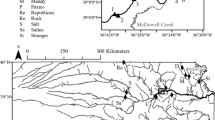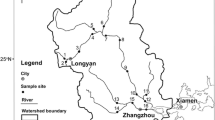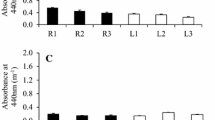Abstract
To better understand the interaction between the abundance and composition of bacterial communities, physicochemical conditions, and bacterial metabolic function, we studied the patterns of bacterial community composition and metabolic function in relation to nutrients, land use, and network position in a large subtropical river. Composition varied across the watershed, and with variation in nutrients in particular. Although these changes were partially driven by overall abundance, bacterial groups responded to nutrients differently across the watershed. Most groups were correlated with suspended particulate materials, yet, abundance of β-proteobacteria was highest with elevated nitrate, and abundance of Actinobacteria was highest with elevated soluble reactive phosphate. Land use weakly influenced composition. Landscape position influenced composition, with downstream mainstem riverine sites differing from more upstream and tributary sites. Both production and respiration were influenced by temperature and organic carbon, but we found that production and growth efficiency were not directly related. Production peaked at intermediate levels of abundance, but no groups were correlated with production. Respiration by free-floating bacteria was positively correlated with proportional abundance of α-proteobacteria, γ-proteobacteria, and Actinobacteria. Finally, we found that land use was a relatively weak influence on community composition, but that variation in nutrients was relatively important for both composition and function.







Similar content being viewed by others
References
Adams, H. E., B. C. Crump & G. W. Kling, 2010. Temperature controls on aquatic bacterial production and community dynamics in arctic lakes and streams. Environmental Microbiology 12: 1319–1333.
Amado, A. M., F. Meirelles-Pereira, L. O. Vidal, H. Sarmento, A. L. Suhett, V. F. Farjalla, J. B. Cotner & F. Roland, 2013. Tropical freshwater ecosystems have lower bacterial growth efficiency than temperate ones. Frontiers in Microbiology 4: 167.
Anderson-Glenna, M. J., V. Bakkestuen & N. J. W. Clipson, 2008. Spatial and temporal variability in epilithic biofilm bacterial communities along an upland river gradient. FEMS Microbiology Ecology 64: 407–418.
APHA, 2005. Standard Methods for the Examination of Water and Wastewater, 21st ed. American Public Health Association, Washington, DC.
Barlett, M. A. & L. G. Leff, 2010. Planktonic bacterial responses to nutrient amendments in wetland mesocosms. Wetlands 30: 1161–1170.
Basu, B. K. & F. R. Pick, 1996. Factors regulating phytoplankton and zooplankton biomass in temperate rivers. Limnology and Oceanography 41: 1572–1577.
Battin, T. J., L. A. Kaplan, S. Findlay, C. S. Hopkinson, E. Marti, A. I. Packman, J. D. Newbold & F. Sabater, 2008. Biophysical controls on organic carbon fluxes in fluvial networks. Nature Geoscience 1: 95–100.
Becker, J. C., K. R. Rodibaugh, B. J. Labay, T. H. Bonner, Y. Zhang & W. H. Nowlin, 2014. Physiographic gradients determine nutrient concentrations more than land use in a Gulf Slope (USA) river system. Freshwater Science 33: 731–744.
Berggren, M. & P. A. del Giorgio, 2015. Distinct patterns of microbial metabolism associated to riverine dissolved organic carbon of different source and quality. Journal of Geophysical Research: Biogeosciences 120: 989–999.
Berggren, M., H. Laudon & M. Jansson, 2007. Landscape regulation of bacterial growth efficiency in boreal freshwaters. Global Biogeochemical Cycles 21: GB4002.
Berggren, M., H. Laudon & M. Jansson, 2009. Aging of allochthonous organic carbon regulates bacterial production in unproductive boreal lakes. Limnology and Oceanography 54: 1333–1342.
Berggren, M., H. Laudon, A. Jonsson & M. Jansson, 2010. Nutrient constraints on metabolism affect the temperature regulation of aquatic bacterial growth efficiency. Microbial Ecology 60: 894–902.
Bergström, A. K. & M. Jansson, 2000. Bacterioplankton production in humic Lake Ortrasket in relation to input of bacterial cells and input of allochthonous organic carbon. Microbial Ecology 39: 101–115.
Biddanda, B., M. Ogdahl & J. Cotner, 2001. Dominance of bacterial metabolism in oligotrophic relative to eutrophic waters. Limnology and Oceanography 46: 730–739.
Bier, R. L., E. S. Bernhardt, C. M. Boot, E. B. Graham, E. K. Hall, J. T. Lennon, D. R. Nemergut, B. B. Osborne, C. Ruiz-González, J. P. Schimel, M. P. Waldro & M. D. Wallenstein, 2015. Linking microbial community structure and microbial processes: an empirical and conceptual overview. FEMS Microbiology 91: fiv113.
Bouvier, T. & P. A. del Giorgio, 2003. Factors influencing the detection of bacterial cells using fluorescence in situ hybridization (FISH): a quantitative review of published reports. FEMS Microbiology Ecology 44: 3–15.
Burnham, K. P. & D. R. Anderson, 2004. Multimodel inference-understanding AIC and BIC in model selection. Sociological Methods & Research 33: 261–304.
Cole, J. J., Y. T. Prairie, N. F. Caraco, W. H. McDowell, L. J. Tranvik, R. G. Striegl, C. M. Duarte, P. Kortelainen, J. A. Downing, J. J. Middelburg & J. Melack, 2007. Plumbing the global carbon cycle: integrating inland waters into the terrestrial carbon budget. Ecosystems 10: 171–184.
Comte, J. & P. A. del Giorgio, 2011. Composition influences the pathway but not the outcome of the metabolic response of bacterioplankton to resource shifts. PLoS ONE 6: e25266.
Cotner, J. B. & B. A. Biddanda, 2002. Small players, large role: microbial influence on biogeochemical processes in pelagic aquatic ecosystems. Ecosystems 5: 105–121.
Crump, B. C., H. E. Adams, J. E. Hobbie & G. W. Kling, 2007. Biogeography of bacterioplankton in lakes and streams of an arctic tundra catchment. Ecology 88: 1365–1378.
Crumpton, W. G., T. M. Isenhart & P. D. Mitchell, 1992. Nitrate and organic N analyses with 2nd-derivative spectroscopy. Limnology and Oceanography 37: 907–913.
del Giorgio, P. A. & T. C. Bouvier, 2002. Linking the physiologic and phylogenetic successions in free-living bacterial communities along an estuarine salinity gradient. Limnology and Oceanography 47: 471–486.
del Giorgio, P. A. & J. J. Cole, 1998. Bacterial growth efficiency in natural aquatic systems. Annual Review of Ecology and Systematics 29: 503–541.
del Giorgio, P. A. & M. L. Pace, 2008. Relative independence of dissolved organic carbon transport and processing in a large temperate river: the Hudson River as both pipe and reactor. Limnology and Oceanography 53: 185–197.
del Giorgio, P. A., M. L. Pace & D. Fischer, 2006. Relationship of bacterial growth efficiency to spatial variation in bacterial activity in the Hudson River. Aquatic Microbial Ecology 45: 55–67.
Falkowski, P. G., T. Fenchel & E. F. Delong, 2008. The microbial engines that drive Earth’s biogeochemical cycles. Science 320: 1034–1039.
Fellman, J. B., R. G. M. Spencer, P. A. Raymond, N. E. Petit, G. Skrzypek, P. J. Hernes & P. F. Grierson, 2014. Dissolved organic carbon biolability decreases along with its modernization in fluvial networks in an ancient landscape. Ecology 95: 2622–2632.
Findlay, S., 2010. Stream microbial ecology. Journal of the North American Benthological Society 29: 170–181.
Gao, X. Q., O. A. Olapade & L. G. Leff, 2005. Comparison of benthic bacterial community composition in nine streams. Aquatic Microbial Ecology 40: 51–60.
Glöckner, F. O., B. M. Fuchs & R. Amann, 1999. Bacterioplankton compositions of lakes and oceans: a first comparison based on fluorescence in situ hybridization. Applied and Environmental Microbiology 65: 3721–3726.
Guillemette, F., S. L. McCallister & P. A. del Giorgio, 2013. Differentiating the degradation dynamics of algal and terrestrial carbon within complex natural dissolved organic carbon in temperate lakes. Journal of Geophysical Research: Biogeosciences 118: 963–973.
Guillemette, F., S. L. McCallister & P. A. del Giorgio, 2016. Selective consumption and metabolic allocation of terrestrial and algal carbon determine allochthony in lake bacteria. The ISME Journal 10: 1373–1382.
Greuter, D., A. Loy, M. Horn & T. Rattei, 2016. probeBase—an online resource for rRNA-targeted oligonucleotide probes and primers: new features 2016. Nucleic Acids Research 44: D586–D589.
Jenkins, D. G., K. A. Medley & R. B. Franklin, 2011. Microbes as a test of biogeographic principles. In Fontaneto, D. (ed), Biogeography of Microscopic Organisms: Is Everything Small Everywhere. Cambridge University Press, New York: 309–323.
Jones, S. E. & J. T. Lennon, 2010. Dormancy contributes to the maintenance of microbial diversity. Proceedings of the National Academy of Sciences of the United States of America 107: 5881–5886.
Kirchman, D. L., A. I. Dittel, S. E. G. Findlay & D. Fischer, 2004. Changes in bacterial activity and community structure in response to dissolved organic matter in the Hudson River, New York. Aquatic Microbial Ecology 35: 243–257.
Kirchman, D. L., A. I. Dittel, R. R. Malmstrom & M. T. Cottrell, 2005. Biogeography of major bacterial groups in the Delaware Estuary. Limnology and Oceanography 50: 1697–1706.
Kritzberg, E. S., J. J. Cole, M. M. Pace & W. Graneli, 2005. Does autochthonous primary production drive variability in bacterial metabolism and growth efficiency in lakes dominated by terrestrial C inputs? Aquatic Microbial Ecology 38: 103–111.
Langenheder, S., E. S. Lindstrom & L. J. Tranvik, 2005. Weak coupling between community composition and functioning of aquatic bacteria. Limnology and Oceanography 50: 957–967.
Lear, G., V. Washington, M. Neale, B. Case, H. Buckley & G. Lewis, 2013. The biogeography of stream bacteria. Global Ecology and Biogeography 22: 544–554.
Legendre, P. & L. Legendre, 2012. Numerical Ecology, 3rd ed. Elsevier, Oxford.
Lindström, E. S., X. M. Feng, W. Graneli & E. S. Kritzberg, 2010. The interplay between bacterial community composition and the environment determining function of inland water bacteria. Limnology and Oceanography 55: 2052–2060.
Liu, L. M., J. Yang, X. Q. Yu, G. J. Chen & Z. Yu, 2013. Patterns in the composition of microbial communities from a subtropical river: effects of environmental, spatial and temporal factors. PLoS ONE 8: e81232.
Maranger, R. J., M. L. Pace, P. A. del Giorgio, N. F. Caraco & J. J. Cole, 2005. Longitudinal spatial patterns of bacterial production and respiration in a large river-estuary: implications for ecosystem carbon consumption. Ecosystems 8: 318–330.
McCallister, S. L. & P. A. del Giorgio, 2008. Direct measurement of the δ13C signature of carbon respired by bacteria in lakes: linkages to potential carbon sources, ecosystem baseline metabolism, and CO2 fluxes. Limnology and Oceanography 53: 1204–1216.
McCallister, S. L. & P. A. del Giorgio, 2012. Evidence for the respiration of ancient terrestrial organic C in northern temperate lakes and streams. Proceedings of the National Academy of Sciences of the United States of America 109: 16963–16968.
Niño-Garcia, J. P., C. Ruiz-González & P. A. del Giorgio, 2016. Interactions between hydrology and water chemistry shape bacterioplankton biogeography across boreal freshwater networks. The ISME Journal 10: 1755–1766.
Ochs, C. A., H. E. Capello & O. Pongruktham, 2010. Bacterial production in the Lower Mississippi River: importance of suspended sediment and phytoplankton biomass. Hydrobiologia 637: 19–31.
Oksanen, J., F. G. Blanchet, R. Kindt, P. Legendre, R. B. O’Hara, G. L. Simpson, P. Solymos, M. H. H. Stevens & H. Wagner, 2012. vegan: Community Ecology Package. Version 2.0-5.
Peres-Neto, P. R., P. Legendre, S. Dray & D. Borcard, 2006. Variation partitioning of species data matrices: estimation and comparison of fractions. Ecology 87: 2614–2625.
Pérez, M. T. & R. Sommaruga, 2006. Differential effect of algal- and soil-derived dissolved organic matter on alpine lake bacterial community composition and activity. Limnology and Oceanography 51: 2527–2537.
Pérez, M. T. & R. Sommaruga, 2011. Temporal changes in the dominance of major planktonic bacterial groups in an alpine lake: discrepancy with their contribution to bacterial production. Aquatic Microbial Ecology 63: 161–170.
R Core Team, 2013. R: A language and environment for statistical computing. R Foundation for Statistical Computing, Vienna.
Ram, A. S. P., S. Nair & D. Chandramohan, 2007. Bacterial growth efficiency in a tropical estuary: seasonal variability subsidized by allochthonous carbon. Microbial Ecology 53: 591–599.
Ramette, A., 2007. Multivariate analyses in microbial ecology. FEMS Microbiology Ecology 62: 142–160.
Read, D. S., H. S. Gweon, M. J. Bowes, L. K. Newbold, D. Field, M. J. Bailey & R. I. Griffiths, 2015. Catchment-scale biogeography of riverine bacterioplankton. The ISME Journal 9: 516–526.
Roiha, T., M. Tiirola, M. Cazzanelli & M. Rautio, 2012. Carbon quantity defines productivity while its quality defines community composition of bacterioplankton in subarctic ponds. Aquatic Sciences 74: 513–525.
Roland, F., N. F. Caraco & J. J. Cole, 1999. Rapid and precise determination of dissolved oxygen by spectrophotometry: evaluation of interference from color and turbidity. Limnology and Oceanography 44: 1148–1154.
Rubin, M. A. & L. G. Leff, 2007. Nutrients and other abiotic factors affecting bacterial communities in an Ohio River (USA). Microbial Ecology 54: 374–383.
Ruiz-González, C., L. Proia, I. Ferrera, J. M. Gasol & S. Sabater, 2013. Effects of large river dam regulation on bacterioplankton community structure. FEMS Microbiology Ecology 84: 316–331.
Ruiz-González, C., G. Salazar, R. Logares, L. Proia, J. M. Gasol & S. Sabater, 2015a. Weak coherence in abundance patterns between bacterial classes and their constituent OTUs along a regulated river. Frontiers in Microbiology 6: 1293.
Ruiz-González, C., J. P. Niño-Garcia, J.-F. Lapierre & P. A. del Giorgio, 2015b. The quality of organic matter shapes the functional biogeography of bacterioplankton across boreal freshwater ecosystems. Global Ecology and Biogeography 24: 1487–1498.
Ruiz-González, C., J. P. Niño-Garcia & P. A. del Giorgio, 2015c. Terrestrial origin of bacterial communities in complex boreal freshwater networks. Ecology Letters 18: 1198–1206.
Salcher, M. M., T. Posch & J. Pernthaler, 2013. In situ substrate preferences of abundant bacterioplankton populations in a prealpine freshwater lake. The ISME Journal 7: 896–907.
Simon, M. & F. Azam, 1989. Protein-content and protein-synthesis rates of planktonic marine bacteria. Marine Ecology Progress Series 51: 201–213.
Smith, D. C. & F. Azam, 1992. A simple, economical method for measuring bacterial protein synthesis rates in seawater using 3H-leucine. Marine Microbial Food Webs 6: 107–114.
Venables, W. N. & B. D. Ripley, 2002. Modern Applied Statistics with S, 4th ed. Springer, New York.
Vidal, L. O., W. Graneli, C. B. Daniel, L. Heiberg & F. Roland, 2011. Carbon and phosphorus regulating bacterial metabolism in oligotrophic boreal lakes. Journal of Plankton Research 33: 1747–1756.
Wang, Y., L. Liu, H. Chen & J. Yang, 2015. Spatiotemporal dynamics and determinants of planktonic bacterial and microeukaryotic communities in a Chinese subtropical river. Applied Microbiology and Biotechnology 21: 9255–9266.
Warkentin, M., H. M. Freese & R. Schumann, 2011. Bacterial activity and bacterioplankton diversity in the eutrophic river warnow—direct measurement of bacterial growth efficiency and its effect on carbon utilization. Microbial Ecology 61: 190–200.
Warton, D. I. & F. K. C. Hui, 2011. The arcsine is asinine: the analysis of proportions in ecology. Ecology 92: 3–10.
Westhorpe, D. P., S. M. Mitrovic, D. Ryan & T. Kobayashi, 2010. Limitation of lowland riverine bacterioplankton by dissolved organic carbon and inorganic nutrients. Hydrobiologia 652: 101–117.
Wetzel, R. G. & G. E. Likens, 1991. Limnological Analyses, 2nd ed. Springer Science + Business Media Inc, New York.
Zarda, B., D. Hahn, A. Chatzinotas, W. Schonhuber, A. Neef, R. I. Amann & J. Zeyer, 1997. Analysis of bacterial community structure in bulk soil by in situ hybridization. Archives of Microbiology 168: 185–192.
Acknowledgements
We thank Alexandra Smith, Alisa Abuzeineh, Ben Labay, Chad Thomas, Cori Schwartz, David Hambright, Frances Lash, Josh Perkin, Katheryn Gilson, Kristen Epp, Matthew Chumchal, Mario Sullivan, Robert Maxwell, Timothy Bonner, and Yixin Zhang for their help and support for this project. We thank the Bernot labs at Ball State University for an early review of this manuscript. We thank three anonymous reviewers for their time and input that helped improve the manuscript. The Nature Conservancy, the Houston Endowment Inc., and the Brazos River Authority provided funding for this project. Additional support was provided by National Science Foundation grant DGE-0742306 to W. Nowlin, T. Bonner, and J. Becker, as well as the Fred & Yetta Richan Aquatic Biology Award and H.D. Schulze scholarships to J. Becker.
Author information
Authors and Affiliations
Corresponding author
Additional information
Handling editor: Stefano Amalfitano
Electronic supplementary material
Below is the link to the electronic supplementary material.
Rights and permissions
About this article
Cite this article
Becker, J.C., Rodibaugh, K.J., Hahn, D. et al. Bacterial community composition and carbon metabolism in a subtropical riverscape. Hydrobiologia 792, 209–226 (2017). https://doi.org/10.1007/s10750-016-3058-2
Received:
Revised:
Accepted:
Published:
Issue Date:
DOI: https://doi.org/10.1007/s10750-016-3058-2




